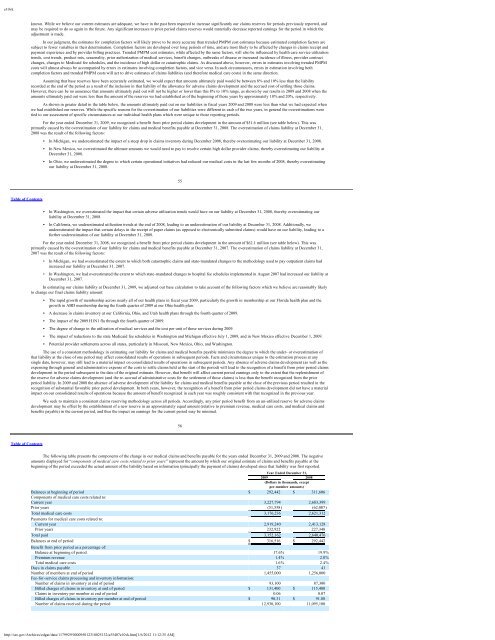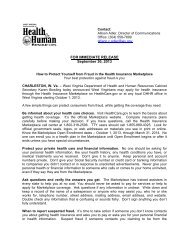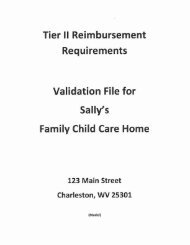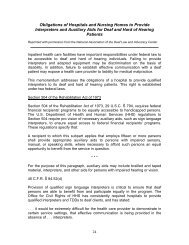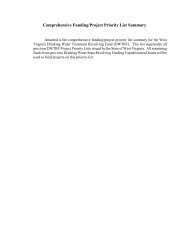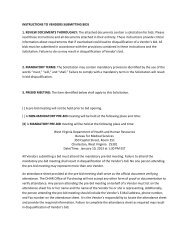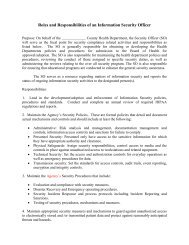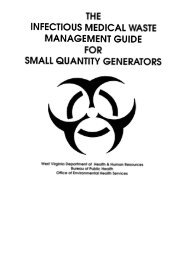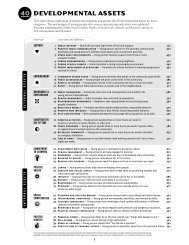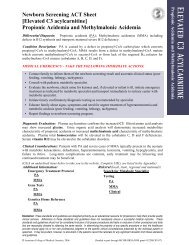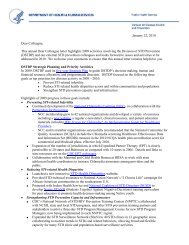Molina Medicaid Solutions - DHHR
Molina Medicaid Solutions - DHHR
Molina Medicaid Solutions - DHHR
Create successful ePaper yourself
Turn your PDF publications into a flip-book with our unique Google optimized e-Paper software.
e10vkknown. While we believe our current estimates are adequate, we have in the past been required to increase significantly our claims reserves for periods previously reported, andmay be required to do so again in the future. Any significant increases to prior period claims reserves would materially decrease reported earnings for the period in which theadjustment is made.In our judgment, the estimates for completion factors will likely prove to be more accurate than trended PMPM cost estimates because estimated completion factors aresubject to fewer variables in their determination. Completion factors are developed over long periods of time, and are most likely to be affected by changes in claims receipt andpayment experience and by provider billing practices. Trended PMPM cost estimates, while affected by the same factors, will also be influenced by health care service utilizationtrends, cost trends, product mix, seasonality, prior authorization of medical services, benefit changes, outbreaks of disease or increased incidence of illness, provider contractchanges, changes to <strong>Medicaid</strong> fee schedules, and the incidence of high dollar or catastrophic claims. As discussed above, however, errors in estimates involving trended PMPMcosts will almost always be accompanied by errors in estimates involving completion factors, and vice versa. In such circumstances, errors in estimation involving bothcompletion factors and trended PMPM costs will act to drive estimates of claims liabilities (and therefore medical care costs) in the same direction.Assuming that base reserves have been accurately estimated, we would expect that amounts ultimately paid would be between 8% and 10% less than the liabilityrecorded at the end of the period as a result of the inclusion in that liability of the allowance for adverse claims development and the accrued cost of settling those claims.However, there can be no assurance that amounts ultimately paid out will not be higher or lower than this 8% to 10% range, as shown by our results in 2009 and 2008 when theamounts ultimately paid out were less than the amount of the reserves we had established as of the beginning of those years by approximately 18% and 20%, respectively.As shown in greater detail in the table below, the amounts ultimately paid out on our liabilities in fiscal years 2009 and 2008 were less than what we had expected whenwe had established our reserves. While the specific reasons for the overestimation of our liabilities were different in each of the two years, in general the overestimations weretied to our assessment of specific circumstances at our individual health plans which were unique to those reporting periods.For the year ended December 31, 2009, we recognized a benefit from prior period claims development in the amount of $51.6 million (see table below). This wasprimarily caused by the overestimation of our liability for claims and medical benefits payable at December 31, 2008. The overestimation of claims liability at December 31,2008 was the result of the following factors:• In Michigan, we underestimated the impact of a steep drop in claims inventory during December 2008, thereby overestimating our liability at December 31, 2008.• In New Mexico, we overestimated the ultimate amounts we would need to pay to resolve certain high dollar provider claims, thereby overestimating our liability atDecember 31, 2008.• In Ohio, we underestimated the degree to which certain operational initiatives had reduced our medical costs in the last few months of 2008, thereby overestimatingour liability at December 31, 2008.55Table of Contents• In Washington, we overestimated the impact that certain adverse utilization trends would have on our liability at December 31, 2008, thereby overestimating ourliability at December 31, 2008.• In California, we underestimated utilization trends at the end of 2008, leading to an underestimation of our liability at December 31, 2008. Additionally, weunderestimated the impact that certain delays in the receipt of paper claims (as opposed to electronically submitted claims) would have on our liability, leading to afurther underestimation of our liability at December 31, 2008.For the year ended December 31, 2008, we recognized a benefit from prior period claims development in the amount of $62.1 million (see table below). This wasprimarily caused by the overestimation of our liability for claims and medical benefits payable at December 31, 2007. The overestimation of claims liability at December 31,2007 was the result of the following factors:• In Michigan, we had overestimated the extent to which both catastrophic claims and state-mandated changes to the methodology used to pay outpatient claims hadincreased our liability at December 31, 2007.• In Washington, we had overestimated the extent to which state-mandated changes to hospital fee schedules implemented in August 2007 had increased our liability atDecember 31, 2007.In estimating our claims liability at December 31, 2009, we adjusted our base calculation to take account of the following factors which we believe are reasonably likelyto change our final claims liability amount:• The rapid growth of membership across nearly all of our health plans in fiscal year 2009, particularly the growth in membership at our Florida health plan and thegrowth in ABD membership during the fourth quarter of 2009 at our Ohio health plan.• A decrease in claims inventory at our California, Ohio, and Utah health plans through the fourth quarter of 2009.• The impact of the 2009 H1N1 flu through the fourth quarter of 2009.• The degree of change in the utilization of medical services and the cost per unit of those services during 2009.• The impact of reductions to the state <strong>Medicaid</strong> fee schedules in Washington and Michigan effective July 1, 2009, and in New Mexico effective December 1, 2009.• Potential provider settlements across all states, particularly in Missouri, New Mexico, Ohio, and Washington.The use of a consistent methodology in estimating our liability for claims and medical benefits payable minimizes the degree to which the under- or overestimation ofthat liability at the close of one period may affect consolidated results of operations in subsequent periods. Facts and circumstances unique to the estimation process at anysingle date, however, may still lead to a material impact on consolidated results of operations in subsequent periods. Any absence of adverse claims development (as well as theexpensing through general and administrative expense of the costs to settle claims held at the start of the period) will lead to the recognition of a benefit from prior period claimsdevelopment in the period subsequent to the date of the original estimate. However, that benefit will affect current period earnings only to the extent that the replenishment ofthe reserve for adverse claims development (and the re-accrual of administrative costs for the settlement of those claims) is less than the benefit recognized from the priorperiod liability. In 2009 and 2008 the absence of adverse development of the liability for claims and medical benefits payable at the close of the previous period resulted in therecognition of substantial favorable prior period development. In both years, however, the recognition of a benefit from prior period claims development did not have a materialimpact on our consolidated results of operations because the amount of benefit recognized in each year was roughly consistent with that recognized in the previous year.We seek to maintain a consistent claims reserving methodology across all periods. Accordingly, any prior period benefit from an un-utilized reserve for adverse claimsdevelopment may be offset by the establishment of a new reserve in an approximately equal amount (relative to premium revenue, medical care costs, and medical claims andbenefits payable) in the current period, and thus the impact on earnings for the current period may be minimal.56Table of ContentsThe following table presents the components of the change in our medical claims and benefits payable for the years ended December 31, 2009 and 2008. The negativeamounts displayed for “components of medical care costs related to prior years” represent the amount by which our original estimate of claims and benefits payable at thebeginning of the period exceeded the actual amount of the liability based on information (principally the payment of claims) developed since that liability was first reported.Year Ended December 31,2009 2008(Dollars in thousands, exceptper-member amounts)Balances at beginning of period $ 292,442 $ 311,606Components of medical care costs related to:Current year 3,227,794 2,683,399Prior years (51,558) (62,087)Total medical care costs 3,176,236 2,621,312Payments for medical care costs related to:Current year 2,919,240 2,413,128Prior years 232,922 227,348Total paid 3,152,162 2,640,476Balances at end of period $ 316,516 $ 292,442Benefit from prior period as a percentage of:Balance at beginning of period 17.6% 19.9%Premium revenue 1.4% 2.0%Total medical care costs 1.6% 2.4%Days in claims payable 37 41Number of members at end of period 1,455,000 1,256,000Fee-for-service claims processing and inventory information:Number of claims in inventory at end of period 93,100 87,300Billed charges of claims in inventory at end of period $ 131,400 $ 115,400Claims in inventory per member at end of period 0.06 0.07Billed charges of claims in inventory per member at end of period $ 90.31 $ 91.88Number of claims received during the period 12,930,100 11,095,100http://sec.gov/Archives/edgar/data/1179929/000095012310025132/a55407e10vk.htm[1/6/2012 11:12:35 AM]


